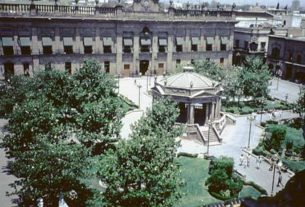April 21, 1519 — the year Ce Acatl (One Reed) by Aztec reckoning — marked the opening of a short but decisive chapter in Mexico’s history. On that day a fleet of 11 Spanish galleons sailing along the eastern gulf coast dropped anchor just off the wind-swept beach on the island of San Juan de Ulúa. Under the command of the wily, daring Hernán Cortés, the vessels bore 550 Spanish soldiers and sailors, as well as 16 horses, the first of the species to tread the American continent.
The party disembarked to set up camp on the dunes behind the beach. In a friendly reception from the native Totonac Indians, greetings and gifts were exchanged. Cognizant of the existence of a great inland Empire, Cortés promptly dispatched a message requesting an audience with Aztec ruler Moctezuma II. (The term “Aztec” will be used throughout, although some historians prefer the less familiar designation “Mexica” for the last of Mexico’s formidable pre-Hispanic civilizations.)
Runners had already carried word to the “Lord of Cuhúa” in Tenochitlán, the capital city set on an island in Lake Texcoco some 200 hundred miles away. They reported the arrival of fair-skinned, bearded strangers and fearsome “man-beasts” (cavalry) who had descended from “towers floating on the sea.”
Cortés wasted no time in staking a claim for God and King, ceremoniously founding a settlement on the coast that he christened Villa Rica de la Vera Cruz, in reference to the fleet’s arrival on Good Friday to what he believed to be a vast land of plenty. The Spanish Conquest had begun.
All odds were against this tiny band of adventurers who would soon venture into unknown territory to topple the mighty Aztec Empire. It could never have happened were it not for Cortés’ remarkable fortitude and cunning, coupled with an incredible series of coincidental prior events.
In the wake the “discovery” of the Western Hemisphere by Christopher Columbus (1492), Spanish and Portuguese explorers continued the quest for riches in the New World. Among these were Francisco Hernández de Córdoba and Juan de Grijalba who, under the orders of Diego Veláquez, Spanish Governor of Cuba, set out on ill-fated ventures to the Yucatan and Mexico’s gulf coast (1517-1518). Velázquez then commissioned the 34 year-old Cortés to lead a new expedition westward, but alarmed by escalating costs, had a last-minute change of heart.
The eager and ever-astute Cortés eluded cancellation of the enterprise by hastily setting sail. The fleet first landed on the island of Cozumel off the Yucatan peninsula. There Cortés ransomed fellow Spaniard Gerónimo de Aguilar who had been forced to live among the Mayas after surviving a 1511 shipwreck during a prior expedition. Aguilar proved an invaluable asset to Cortés, acting as his personal interpreter of both native language and culture.
Communication problems arose anew, however, as the Spaniards sailed farther north, encountering natives who spoke a different tongue. Fortuitously, the spoils of victory over a Tabascan chieftain at Potonchán included a gift of twenty native maidens, one of whom was fluent in both the Náhuatl and Mayan tongues. The comely and clever Malintzin was promptly baptized with a Spanish name, Marina, and appointed the task of intervening in further contacts with indigenous peoples. She translated Náhuatl to Mayan for Aguilar, who then put her words into Spanish.
Doña Marina soon earned her place as Cortés’ most intimate adviser by first mastering Spanish and then becoming his mistress. Eventually she bore him a son, Martín, the first mixed-blood Mexican or mestizo. For having aided the Spaniards, today she is widely considered a traitor to her own people. The moniker by which she is mostly commonly known, la Malinche, gave rise to the modern-day term malinchista used in reference a Mexican who takes a fancy to anything of foreign origin.
Meanwhile, back in Tenochitlán, Moctezuma was in a quandary as to how to best deal with the unwelcome strangers. Ancient legend prophesied that Quetzalcoátl, the bearded, fair-skinned Toltec ruler-god, would return from the east in the year Ce Acatl to reclaim his kingdom. Evil omens that had confounded the Aztec priests and sorcerers over the previous decade only heightened Moctezuma’s anxiety. First, despite fair weather, the waters of Lake Texcoco had suddenly boiled up, flooding the island of their capital city. Then an inexplicable conflagration had consumed the temple of their chief god, Huitzilopochtli. The voice of a woman wailing in the night had repeatedly disturbed the city’s slumber. Immense comets with fiery tails had been seen shooting through day-time skies and a great column of fire had appeared in the east every night for an entire year. All of these were taken to be signs of Quetzalcoátl’s imminent return.
A hostile reception of the mighty Plumed Serpent or his emissaries was unthinkable. So Moctezuma sent Cortés a cordial message, but cautioned him against proceeding to the Aztec capital. It was, he noted, an arduous journey through deserts, mountains and dangerous enemy territories. He also sent many fine gifts, tokens of his esteem which he hoped would placate the strangers or, better still, spur them to return from whence they came.
The gold and other Aztec finery only whetted the Spaniards’ appetite for new world riches. Determined to carry forward, the next moves Cortés made were as astute as they were bold. After dispatching trusted envoys back to Spain to deliver letters and Aztec treasure to his monarch, Carlos V, he stripped and scuttled the remainder of his fleet. This drastic measure constituted a blatant act of rebellion against his direct superior, Governor Velázquez, but by effectively eliminating any means of desertion, Cortés hoped to assure the do-or-die loyalty of his men.
Through cunning and intrigue Cortés forged an alliance with the Totonacs at the coastal city-state Cempoala, then under Aztec dominion. The Spanish army was thus beefed up with more than a thousand native warriors plus 200 porters. With a small party left to hold the fort at Vera Cruz, Cortés commenced the hazardous journey towards the Aztec capital.
To the east of the great twin volcanoes Popocatépetl and Ixtaccíhuatl lay the first obstacle, the small kingdom of Tlaxcala whose fierce mountain people who had long managed to defy Aztec dominance. Suspecting the odd strangers to be agents of Moctezuma the Tlaxcalans promptly engaged the Spaniards in battle. Superior weaponry and military tactics, added to internecine rivalry between Tlaxcalan generals, helped Cortés prevail despite the fact that his troops were greatly outnumbered. The subsequent Spanish-Tlaxcalan alliance proved to be a crucial factor in the ultimate downfall of the Aztecs.
Next came a dangerous interlude at the great ceremonial center, Cholula. Warned by la Malinche that a plot was afoot to ambush and capture the Spaniards, Cortés outfoxed the Cholulan caciques (native chieftains), engineering a surprise attack in the city’s center that left thousands dead. The Tlaxcalans joined in the fray, razing Cholula in a two-day rampage.
Finally the Spaniards approached their destination, descending into the Valley of Mexico from a high mountain pass between the great volcanoes. In early November 1519, with Cortés in the lead, they filed across the southern causeway into the magnificent Tenochtitlán. They were received with much ceremony by a retinue of lords and nobles headed by Moctezuma himself, and escorted to their quarters in the ancient palace of Atzayacatl, the emperor’s father. The wary Moctezuma made great efforts to play the perfect host, showing his unwanted guests around the city and entertaining them with splendid banquets.
Aware of the precarious situation in which he had placed his band of adventurers, Cortés made an extraordinarily bold move to secure their safety. He took Moctezuma captive, holding him in the Spaniards quarters. This bizarre state of affairs continued for eight months until news came that Spanish troops sent by the Cuban Governor Velázquez had arrived at the coast had arrived to place Cortés under arrest. Leaving a garrison in charge in the Aztec capital, Cortés marched back eastward with a band of his finest soldiers. He defeated his intended captors in battle at Cempoala, and soon was headed back to Tenochtitlán with the newcomers in tow.
In his absence, Pedro de Alvarado, the garrison’s commander, ordered an attack on the Aztecs in the midst of what he viewed as an alarmingly frenetic religious celebration. Enraged by the vicious slaughter, the native population rebelled. Upon his return, Cortés tried to quell the hostilities by persuading Moctezuma to mount the roof of Atzayacatl’s palace and appeal to his people for peace. Their response was to shower the emperor with insults, stones and arrows, inflicting physical and mental injury that soon resulted in his death.
Under Moctezuma’s successor, Cuitláhuac (who succumbed to smallpox several months later), the Aztecs mounted a full-scale siege on the conquistadores. With food and water scarce, the Spaniards and their Tlaxcalan allies attempted to slip out of the city under cover of darkness on what is now known as La Noche Triste, the Sad Night. An alarm was sounded and the Aztecs attacked with fury. Hundred of soliders were killed or captured. Others, weighted down with the gold and silver loot they had collected, fell into the canals and drowned. A despondent Cortés collapsed and wept beneath the famous ahuehuete tree that still stands today in the Mexico City suburb of Tacuba.
Damaged but not entirely disheartened, the surviving Spaniards and their allies retreated back into Tlaxcalan territory to regroup. In subsequent months they healed their wounds and trained for battle. Devising a new strategy, Cortés built a fleet of brigantines for his next attack.
In January 1521 the conquistadores once again entered the valley of Mexico. They staged a series of raids throughout the countryside and took the Aztec stronghold at Texcoco, from whence they could launch the newly built fleet. In May Cortés began his final assault on Tenochtitlán, bearing down from every direction, with separate divisions assigned to each of the city’s three causeways and the flotilla moving in by water.
The Aztecs fought valiantly under leadership of the last Aztec emperor, Cuauhtemoc, whose name translates as “falling eagle” or alternately “setting sun.” Ravaged by diseases introduced by the Spaniards, deprived of fresh water and food supplies from the mainland, they withstood an 80-day siege, surrendering August 13, 1521, only after their captured leader grasped the dagger in Cortés’ belt and pleaded, “I have done all that I could to defend my people. Do with me now what you will.”
Their fervor fueled by victory, the conquistadores lay the Aztec empire to waste, erasing the remnants of the culture as best they could, scorching Tenochtitlán by fire, leveling its majestic temples. The rubble would make up the foundations of a new world, the cradle of a brand new people.


